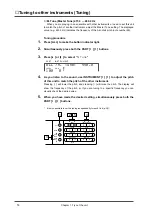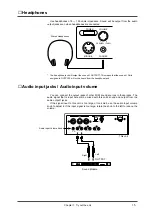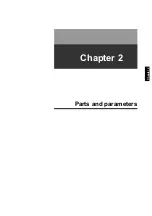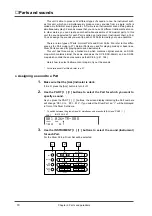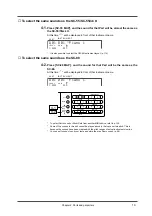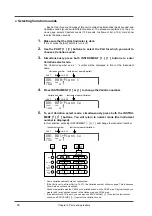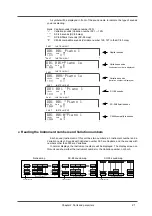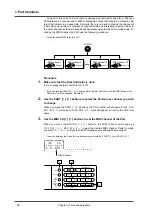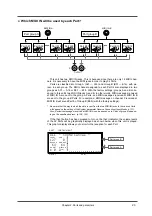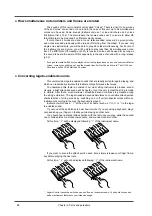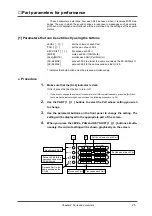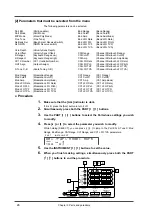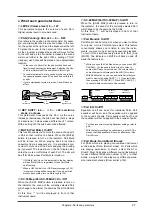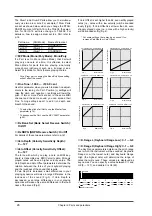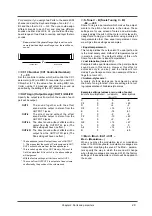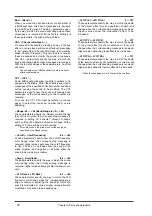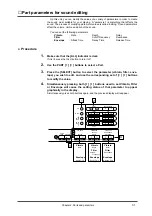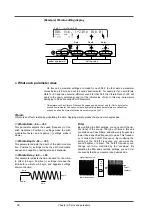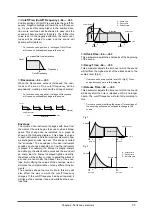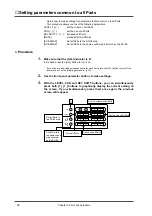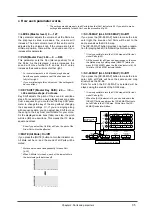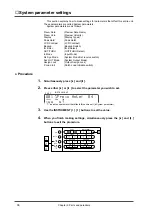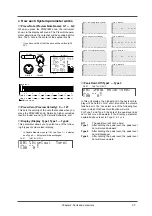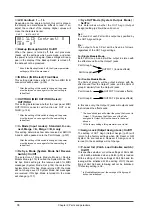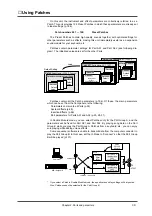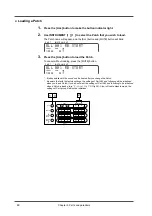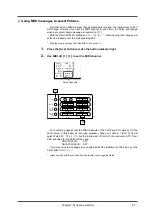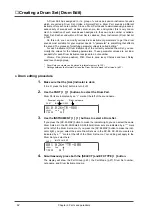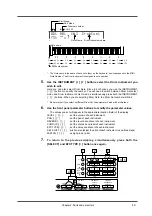
The Drum1 and Drum2 Parts allow you to simultane-
ously use two drum sets. For example if Drum Parts
are set as shown below, when you change the STAN-
DARD1 drum set of Part A10 to the TR-808, the selec-
tion for Part A12 will also change to TR-808. For
details on how to assign a drum set to a Part, refer to
p.18.
Part name
(Part Mode)
Name of drum set
Part A10
(Drum1) :
STANDARD 1
Part A11
(Drum2) :
JAZZ
Part A12
(Drum1) :
STANDARD 1
❍
M/P Mode (Mono/Poly Mode): Mono/Poly
If a Part is set to Mono (Mono Mode), that Part will
play only one note at a time. It is effective to select
Mono Mode for parts that are playing a naturally
monophonic instrument such as a trumpet or sax.
Select Poly Mode for Parts that are playing chords.
* For a Drum part, changing the Mono/Poly Mode setting
will not affect the sound.
❍
Fine Tune: -100.0 — +100.0 cent
Use this parameter when you wish to make fine adjust-
ments to the tuning of a Part. Positive (+) settings will
raise the pitch, and negative (-) settings will lower the
pitch. If two or more Parts are set to the same MIDI
channel and the same sound, you can spread their
Fine Tuning settings apart to add rich depth and
breath to the sound.
* To adjust the pitch of all Parts, use the Master Tune
parameter (p.14).
* To transposes the Part, use the KEY SHIFT parameter
(p.25).
❍
Rx Bank Sel (Bank Select Receive Switch):
On/Off
❍
Rx NRPN (NRPN Receive Switch): On/Off
For details of these two parameters, refer to p.141.
❍
Velo Depth (Velocity Sensitivity Depth):
0 — 127
❍
Velo Offset (Velocity Sensitivity Offset):
0 — 127
The force with which you play a note on MIDI key-
board is transmitted as MIDI Velocity data. Strongly
played notes will have a higher velocity value. The
Velo Depth and Velo Offset parameters determine the
relation between the force of your keyboard playing
and the loudness of the sound that results.
If Velo Depth is increased, small differences in your
playing dynamics will make a large difference in the
loudness of the sound (Fig.3). If Velo Depth is
decreased, even large differences in your playing
dynamics will make only a small difference in the loud-
ness of the sound (Fig.2).
If Velo Offset is set higher than 64, even softly played
notes (i.e., notes with a low velocity) will be sounded
loudly (Fig.5). If Velo Offset is set lower than 64, even
strongly played notes (i.e., notes with a high velocity)
will be sounded softly (Fig.4).
* For some settings, there may be no sound. If so,
increase Velo Depth or Velo Offset.
❍
K. Range L (Keyboard Range Low): C-1 — G9
❍
K. Range H (Keyboard Range High): C-1 — G9
The Key Range parameters determine the pitch range
over which the instrument will be sounded. Keyboard
Range Low (the lowest note) and Keyboard Range
High (the highest note) will determine the range of
notes that will sound. These values are displayed as
key names. You can specify a value between C-1 and
G9 (0 — 127), and middle C is C4 (60).
Velo Depth = 64, Velo Offset = 64
MIDI Velocity
The actual sound level
Fig. 1
Velo Depth = 32, Velo Offset = 64
MIDI Velocity
The actual sound level
Fig. 2
Velo Depth = 127, Velo Offset = 64
MIDI Velocity
The actual sound level
Fig. 3
Velo Depth = 64, Velo Offset = 32
MIDI Velocity
The actual sound level
Fig. 4
Velo Depth = 64, Velo Offset = 96
MIDI Velocity
The actual sound level
Fig. 5
Velo Depth = 64, Velo Offset = 127
MIDI Velocity
The actual sound level
Fig. 6
C1
C2
C3
C4
C5
C6
C7
C8
A0
C-1
24
36
48
60
72
84
96
108
21
0
Note name
MIDI note number
Chapter 2. Parts and paramters
28
Summary of Contents for SoundCanvas SC-88 Pro
Page 9: ...Chapter 1 Try out the unit Quick start Chapter 1...
Page 18: ...Chapter 1 Try out the unit 16...
Page 19: ...Chapter 2 Parts and parameters Chapter 2...
Page 47: ...Chapter 3 System Effects Chapter 3...
Page 57: ...Chapter 4 Insertion Effects Chapter 4...
Page 97: ...Chapter 5 Convenient functions Chapter 5...
Page 121: ...Chapter 6 Using the unit with a personal computer Chapter 6...

